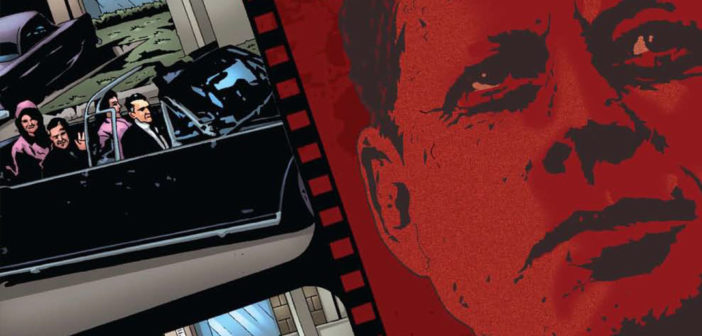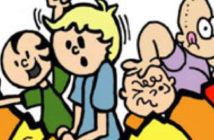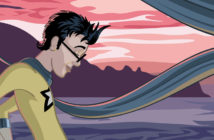Jay Busbee and Jason Flowers’ Ripped began as a guilty pleasure: the protagonist, Adam Fitzpatrick (his buddies call him simply “Fitz”) is a typecast protagonist who is lazy and underachieves. Each day doesn’t present him with a new opportunity to shock and awe the world so much as it sets up a series of minor hurdles that need to be traversed until night falls and it’s time to hit the sack. As Artie Lange once said on the Howard Stern radio show, being an underwhelming loser has its advantages because as such no one expects anything of you. Ah, the colloquial wisdom of a contemporary jester.
I say Ripped is initially a guilty pleasure because the disinterested Fitz is thrust into an adventure that spans time and space: this is the daydream of many a fanboy if I’ve ever heard of one. And, without hesitation, I was caught up in it—Fitz has his charm, after all. He’s observant and never fails to have a smart-ass remark when the situation calls for some levity. The key: he’s relatable, and his journey could be that of any reader because he’s not some grandiose, garish deity who can save the world a hundred times over without breaking a sweat. He’s a dude, and I like dudes.
But Ripped is crafty, a lot craftier than I originally gave it credit for. Granted, Fitz is a bit of a klutz as he travels throughout his journey, but he learns and grows, and because he’s uncluttered from a potential cast of sodden supporting characters, we learn about him by witnessing his transformation from a completely disinterested youth into a somewhat caring adult (I emphasize somewhat).
As the title of the book implies, Fitz is what’s known as a “ripper,” someone who is able to rip through time and move throughout history. Writer Busbee offers a weak explanation of why rippers exist and what their purpose in the grand scheme of things is, but I chose to ignore it. When dealing with stories of time travel, it’s safest not to over-explain. It’s a guaranteed bloody bullet wound in the foot.
The story opens with Fitz hanging out with his pals in a mall food court when an explosion takes place. The next thing Fitz knows, he’s sleeping on a bench in Dallas, Texas. By the way: the year is 1963. November 22, 1963, at around noon I’d say. Yes, that’s right: Fitz is presented with the chance to stop the assassination of President John F. Kennedy. And he’s successful, too, but at the cost of Jacqueline Kennedy’s life. And it’s here that Fitz is taken under the wing of Chen, a fellow ripper who tries to teach him the ropes of time travel. Nothing is really said about the responsibility of a ripper, but I’m assuming it’s to screw things up as little as possible. At least that’s what Grandpa Simpson taught me, anyway.
Fitz’s journey eventually leads him out of the Dallas of 1963 to the Trojan War, World War I and II, and then back to his own time. And it’s around the events of the First World War that I began to appreciate the illustrations of artist Flowers: his artwork is very much the cartooning ruminations of a comic book, but they delicately dance with the sharp surrealism that takes place as the plot unfolds. It’s also here that Busbee takes a courageous chance as a fiction writer: he attempts to personalize a young Adolf Hitler. It goes without saying that this is a delicate issue, but from my perspective, he’s successful in achieving what he needs to.
The young Adolf is not glamorized, but he is shown as a freedom-fighter of sorts for Germany against thugs and bandits taking advantage of the war for greed and terror. Heated debates and arguments of this nature are well known to us all today: in the wake of the wars in Iraq and Afghanistan, it’s often questioned who is right and who is wrong in combat. But, of course, the answer is often a foggy and murky shade of gray. World War II still happens, and the teenage Adolf turns into the tyrannical Hitler we all know from history class, but Fitz’s encounter adds texture to a maniacal man the world is fascinated with and cannot stop invoking (note that fascination does not equal admiration). This is where Ripper transitioned from a guilty pleasure into a more serious piece of fiction in comics.
There is a lot I haven’t mentioned about the book, and I won’t bother now. There’s a villain involved, as to be expected, as well as various allies to Fitz throughout his journey, but it’s best to meet them by reading the book. And it’s definitely a book worth reading, because Ripped takes a reluctant everyman and thrusts him into a chronological odyssey that he reacts to as naturally as any normal guy would. Sometimes he panics and other times he makes awful mistakes, but in the end he always tries to help out by doing the right thing. I like to think anyone else would follow the same example.
This comic book review originally appeared on Broken Frontier.




